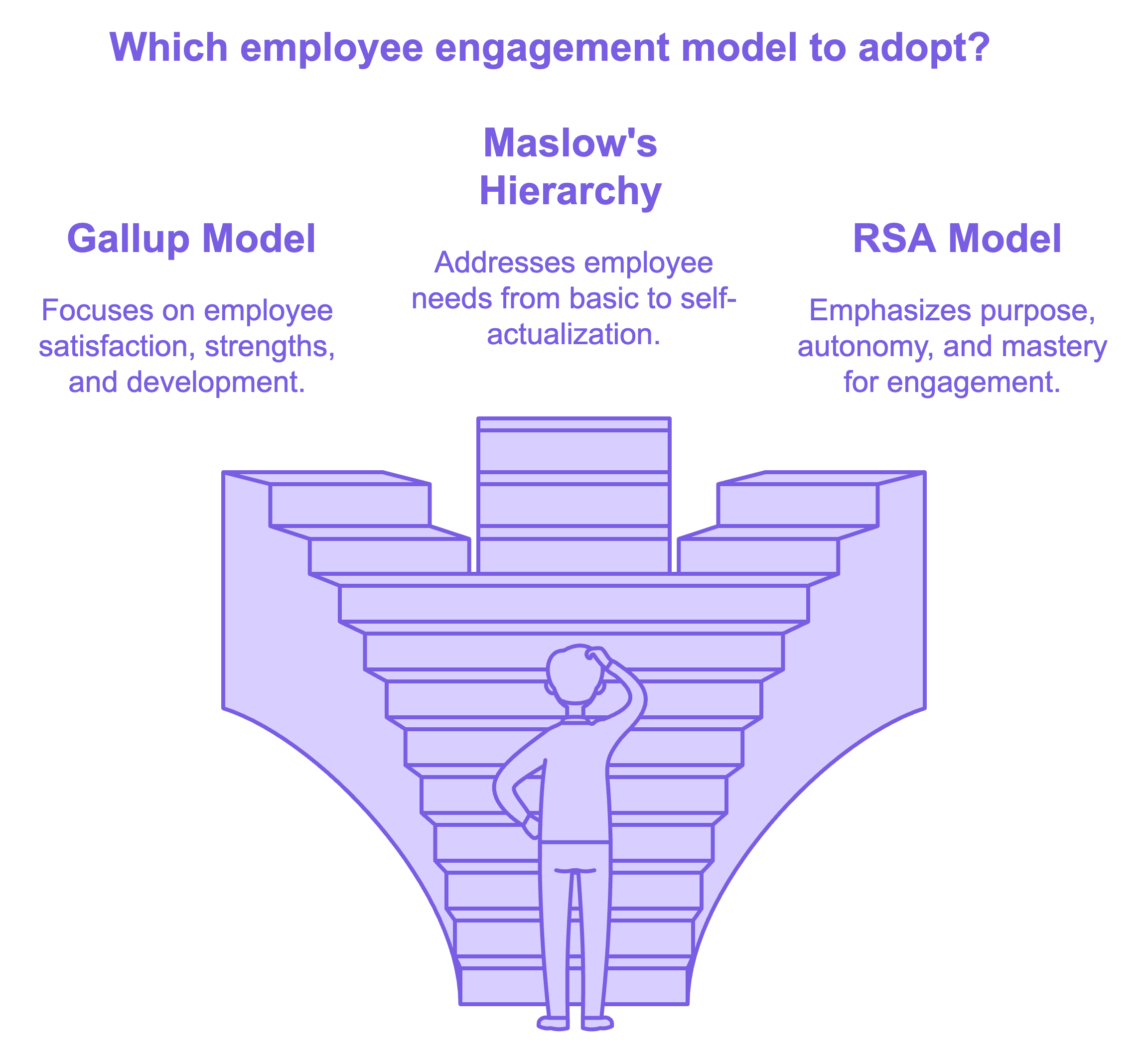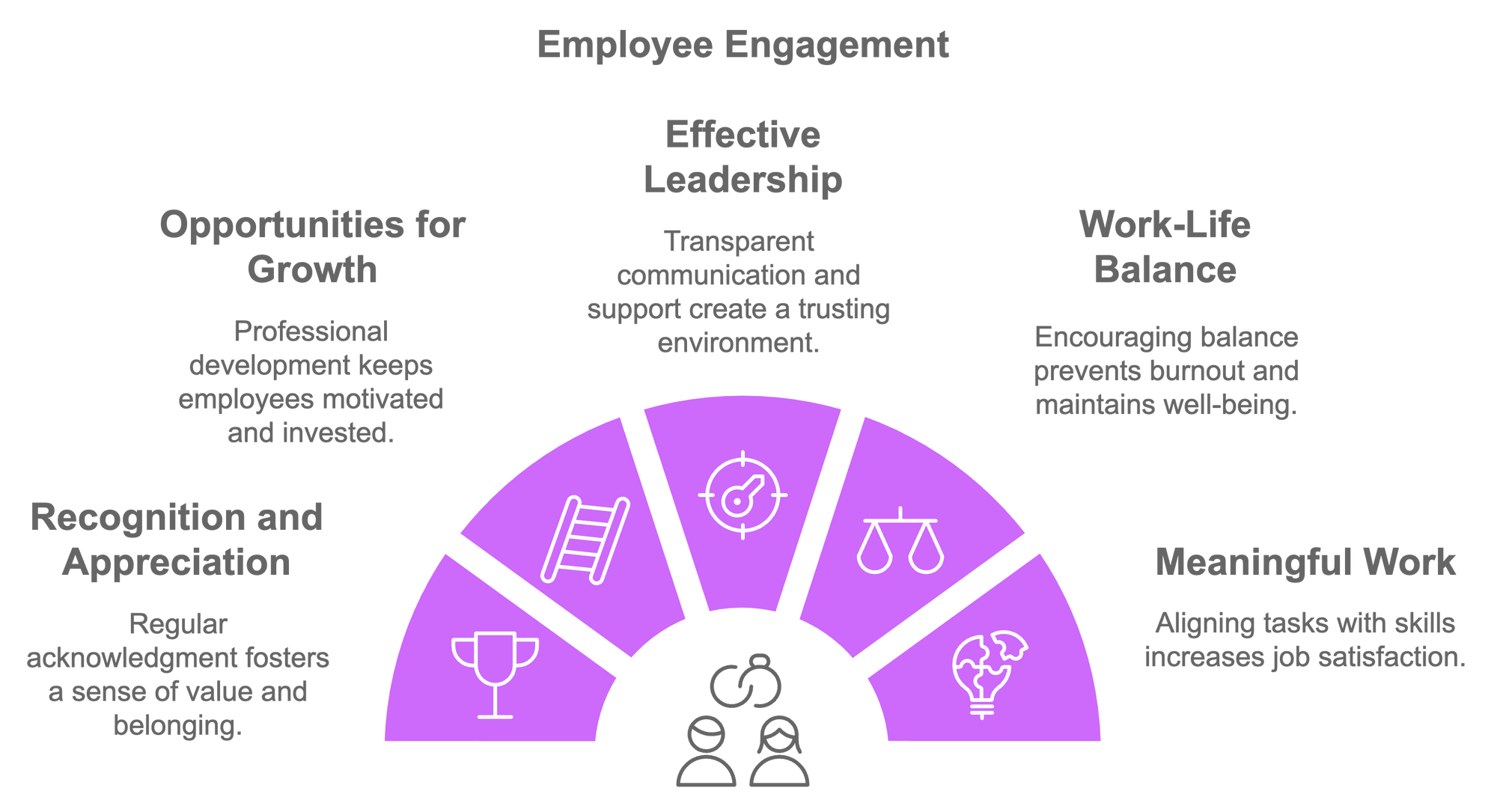Employee engagement models are structured frameworks that organizations use to understand, measure, and enhance employee commitment and motivation. These models provide insights into the factors that influence engagement and offer strategies to foster a more dedicated and productive workforce. This article explores different employee engagement models, why they are critical, and how you can leverage them to boost productivity and reduce turnover.

What is an Employee Engagement Model?
An employee engagement model is a conceptual framework used to understand what motivates employees and what keeps them committed to their work and the organization. These models typically cover aspects like leadership, recognition, opportunities for development, and overall work culture, which collectively influence how engaged an employee feels. They provide actionable steps that companies can take to improve employee morale and productivity, making them an essential tool for effective people management. .
Why Companies Require Employee Engagement Models
Implementing an employee engagement model is crucial for several reasons:
- Enhanced Productivity: Engaged employees are more motivated and efficient, leading to higher productivity levels. A Gallup study found that organizations with high employee engagement are 21% more profitable.
- Reduced Turnover: Engaged employees are less likely to leave their jobs, which helps organizations reduce turnover rates and the associated costs of hiring and training new staff. Research indicates that companies with high engagement levels experience 59% less turnover.
- Improved Customer Satisfaction: Employees who are engaged tend to provide better customer service, leading to higher customer satisfaction and loyalty.
- Innovation and Growth: Engaged employees are more likely to contribute innovative ideas and solutions, driving organizational growth and adaptability.
These factors collectively demonstrate the strategic value of using an engagement model to boost overall company performance.
Factors That Increase Workplace Employee Engagement
Several key factors contribute to enhancing employee engagement within the workplace:
- Recognition and Appreciation: Regular acknowledgment of employees' efforts and achievements fosters a sense of value and belonging. Studies show that recognition is a critical driver of employee engagement. Check out this Happily.ai article on recognition for more insights.
- Opportunities for Growth: Providing avenues for professional development and career advancement keeps employees motivated and invested in the organization's success.
- Effective Leadership: Leaders who communicate transparently, set clear expectations, and support their teams cultivate a trusting and engaging work environment.
- Work-Life Balance: Encouraging a healthy balance between work and personal life helps prevent burnout and maintains employee well-being.
- Meaningful Work: Assigning tasks that align with employees' skills and interests increases job satisfaction and engagement.
- Strong Workplace Relationships: Fostering positive relationships among colleagues enhances collaboration and a sense of community. Strong friendships at work play an important role in employee engagement, as explained in this Happily.ai article.

List of Effective Employee Engagement Models
- The Zinger Model: Developed by David Zinger, this model emphasizes 10 key actions to foster engagement, including building relationships, recognizing contributions, and achieving results.
- The Gallup Q12 Model: Based on extensive research, Gallup identified 12 core elements that drive employee engagement, such as having clear expectations, receiving regular feedback, and opportunities to learn and grow. .
- The AON-Hewitt Model: This model focuses on three primary behaviors—Say, Stay, and Strive—to assess engagement levels. It examines whether employees speak positively about the organization, intend to remain, and are motivated to exert extra effort.
- The JD-R Model (Job Demands-Resources): This framework posits that employee well-being and engagement are influenced by the balance between job demands (e.g., workload) and resources (e.g., support, autonomy).
- The Kahn Model: Proposed by William Kahn, this model identifies three psychological conditions necessary for engagement: meaningfulness, safety, and availability.
These models provide different lenses through which engagement can be understood and improved. Adopting one that fits your organization's context can lead to meaningful changes in productivity and morale.
Employee Engagement Post-Measurement
Measuring employee engagement is essential for identifying areas of improvement and implementing effective strategies. Common methods include:
- Surveys: Utilizing tools like the Gallup Q12 survey to assess engagement levels through targeted questions.
- Focus Groups: Conducting group discussions to gather qualitative insights into employee experiences and perceptions.
- One-on-One Interviews: Engaging in individual conversations to delve deeper into specific concerns and suggestions.
After measurement, analyzing the data to identify trends and areas needing attention is crucial. Developing action plans based on these insights and regularly monitoring progress ensures continuous improvement in engagement levels.
Improving Employee Engagement Models with Happily.ai
Happily.ai offers a comprehensive employee engagement platform designed to enhance employee engagement through real-time feedback, recognition, and analytics. By leveraging behavioral science and AI, Happily.ai enables organizations to:
- Monitor Engagement: Utilize pulse surveys and sentiment analysis to gauge employee engagement continuously.
- Facilitate Recognition: Encourage peer-to-peer recognition to build a culture of appreciation and motivation.
- Analyze Data: Access detailed analytics to understand engagement drivers and inform strategic decisions.
Implementing tools like Happily.ai can lead to significant improvements in employee satisfaction, productivity, and retention.
Conclusion
Employee engagement models are frameworks that help organizations understand and enhance employee commitment and motivation. Implementing these models leads to increased productivity, reduced turnover, and improved customer satisfaction. Tools like Happily.ai provide real-time insights and strategies to foster a more engaged workforce, ultimately contributing to a healthier and more successful organization.









